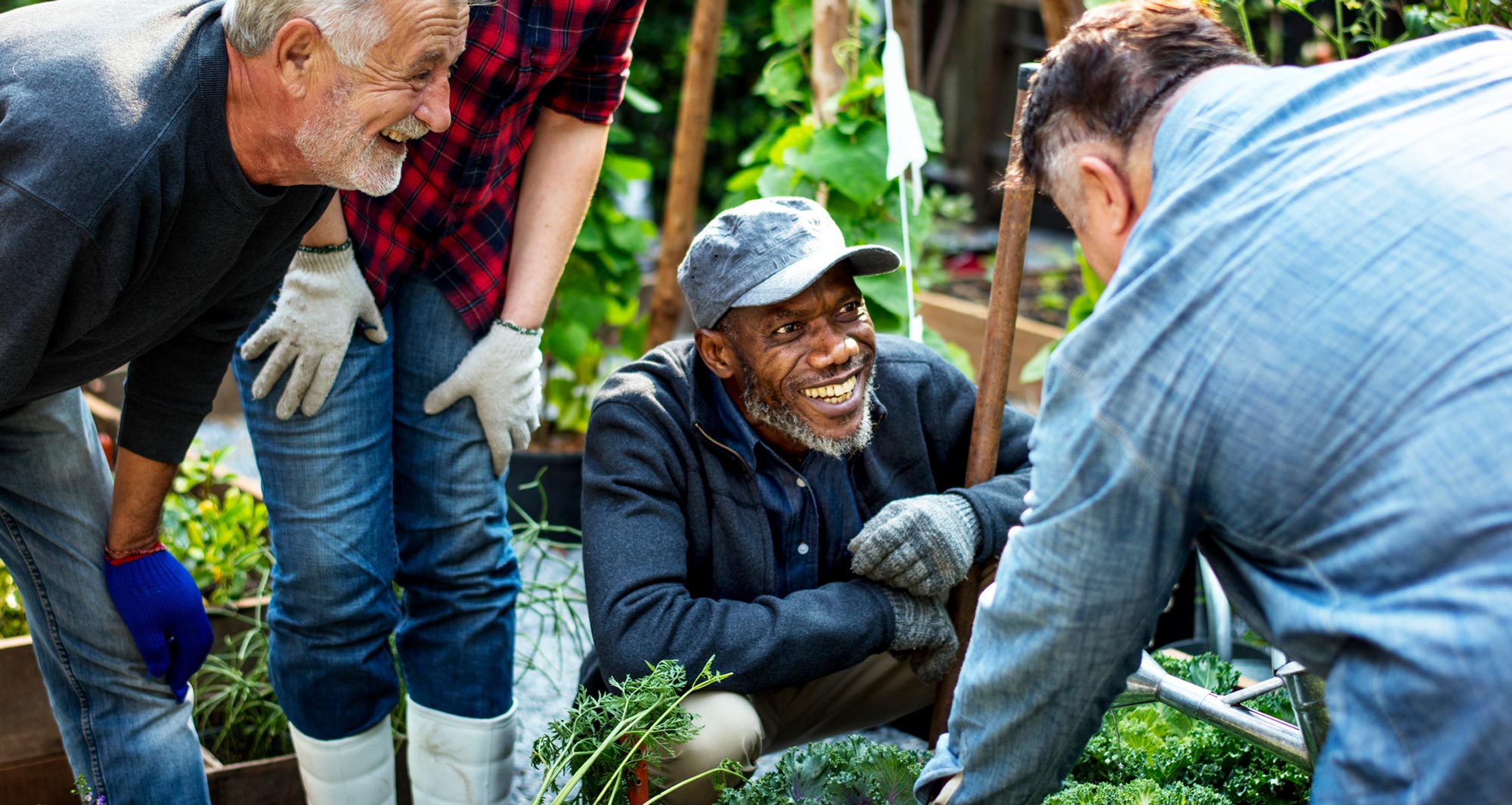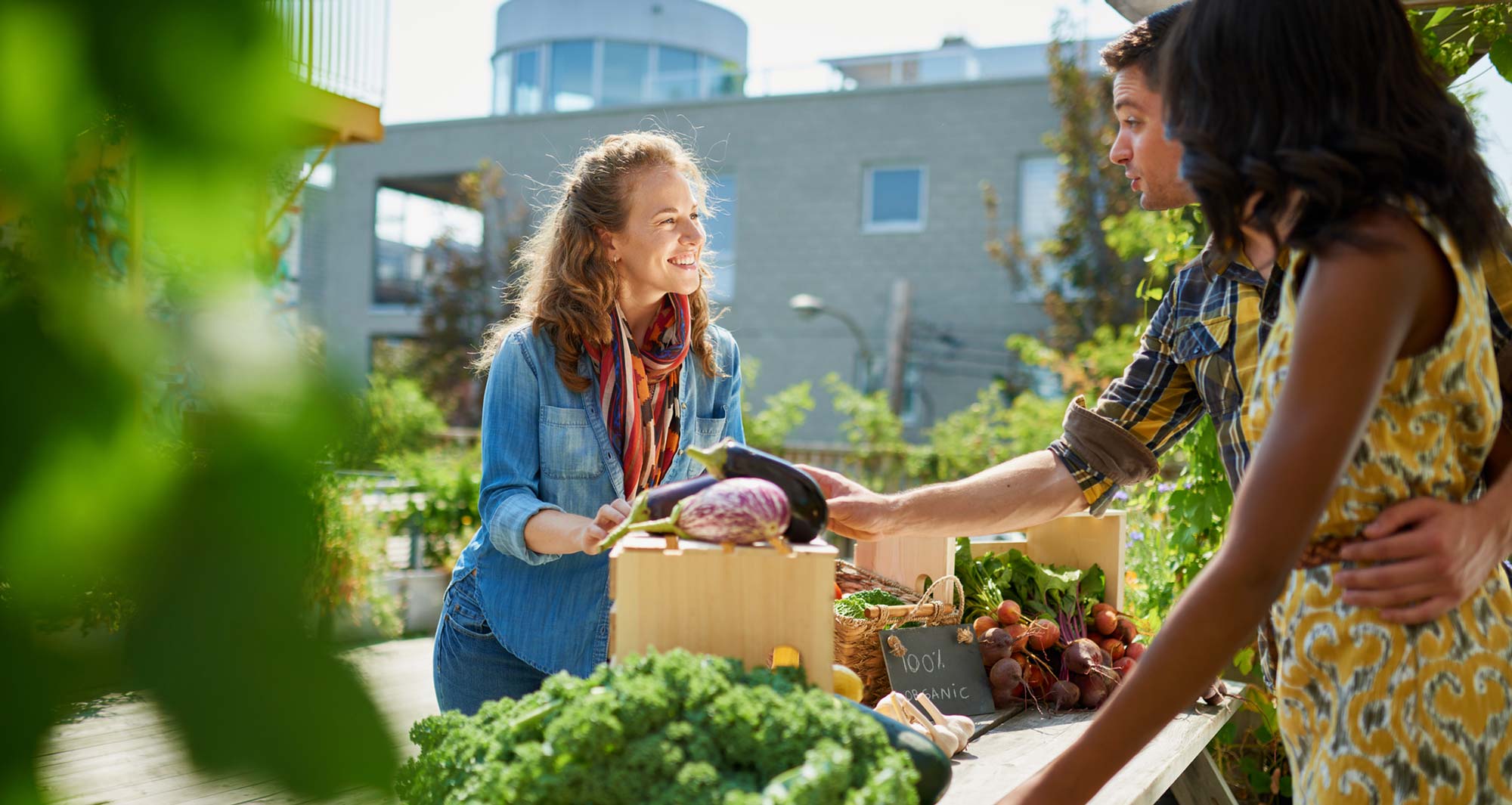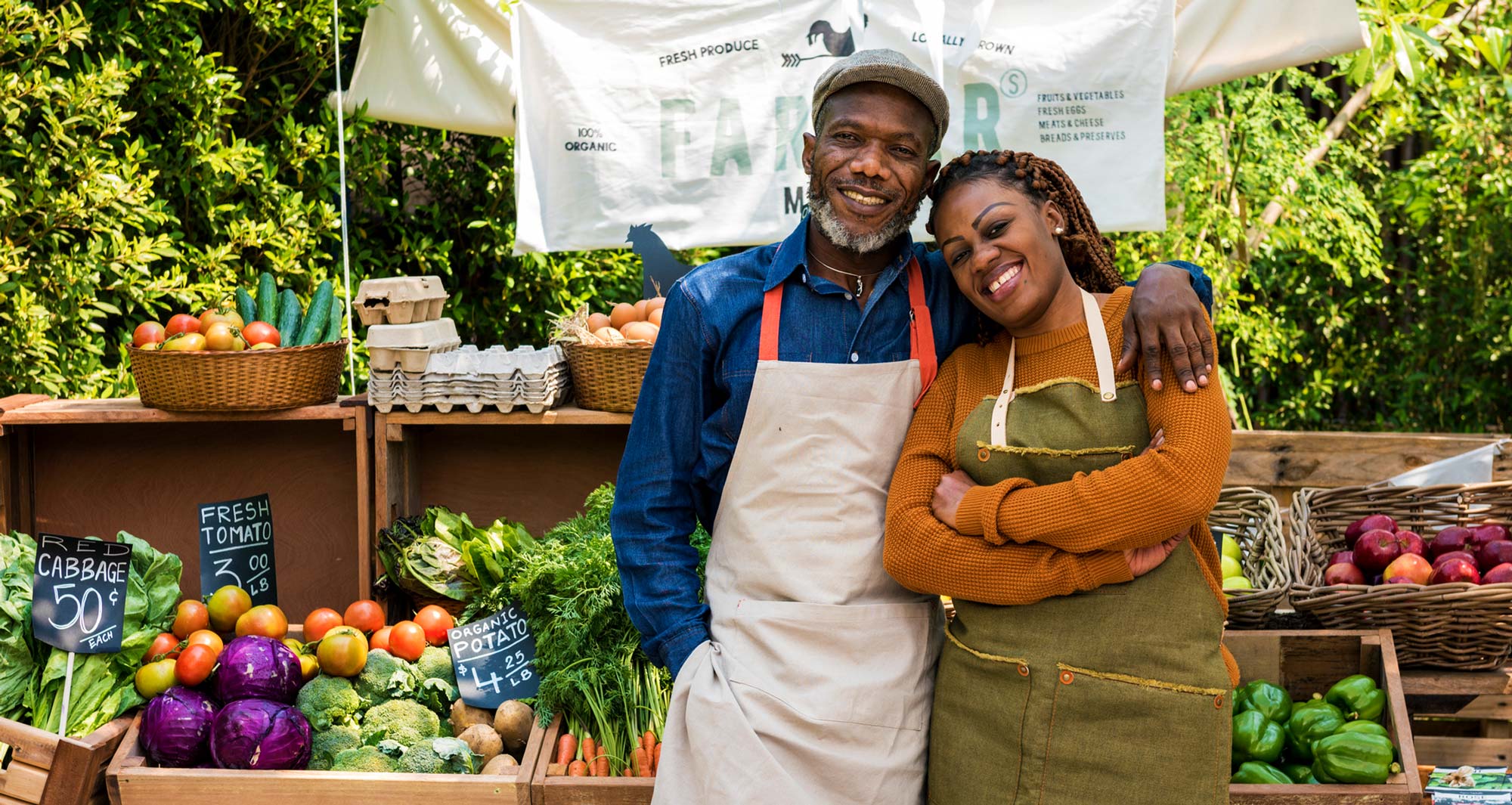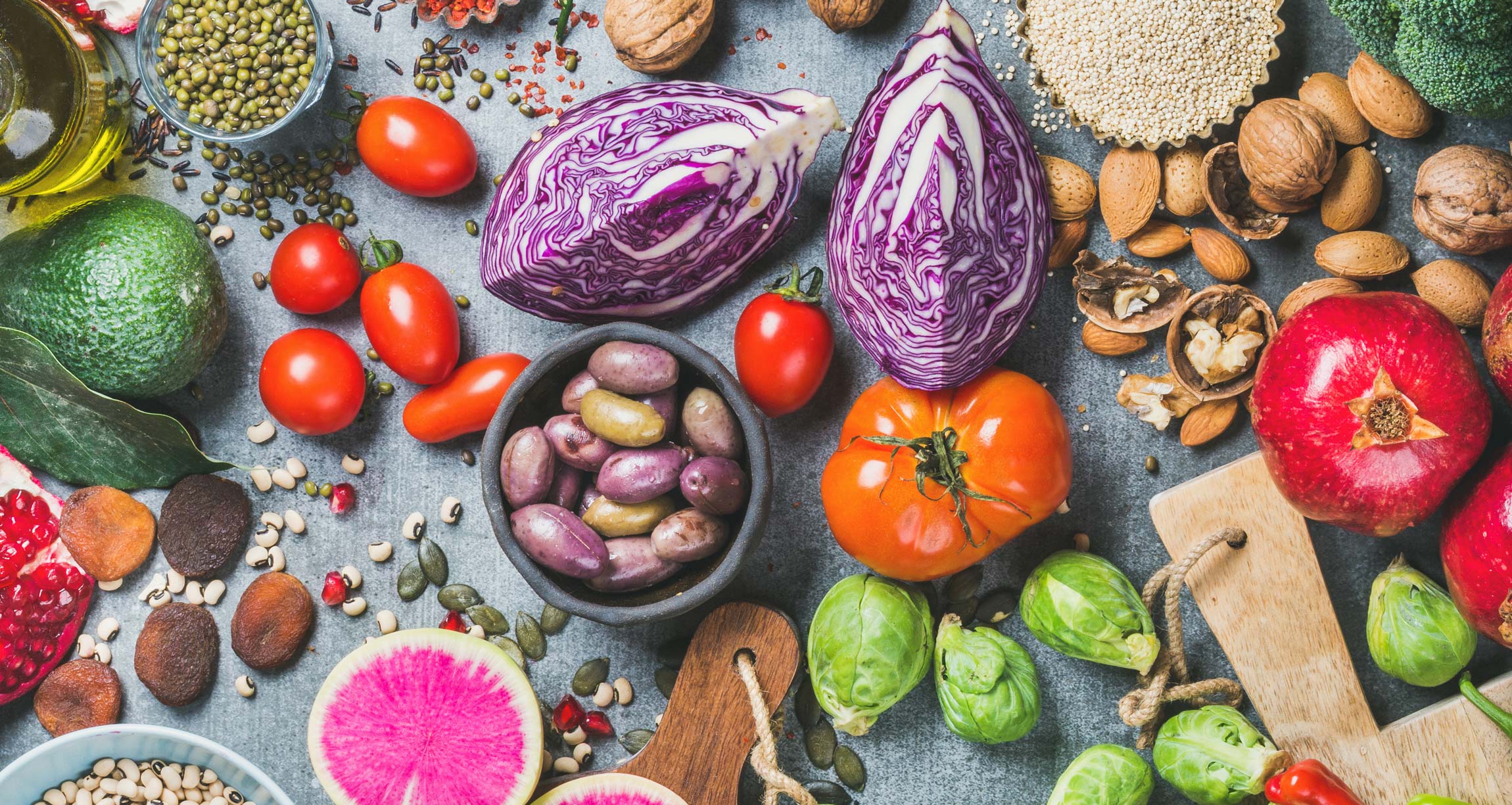Discover why it’s important to buy local food, the health benefits of eating locally grown produce, and why choosing local food benefits the environment.
Have you wondered why it’s important to buy local food?
Local food is now a mainstream trend, with more and more people seeking out fresh, local options for produce and other foods. And more restaurants are sourcing locally grown ingredients as well, often using the term farm-to-table.
But what is “local” food? How big of an impact does eating local food have on your health and the planet? And why is it important to know more about where your food comes from?
What Is Local Food and Why Should You Care?
There’s no formal definition of the term local food. But one common definition of “local” food is food grown within 100 miles of its point of sale or consumption.
But it’s up to you to decide what buying local food means to you. Maybe it means foods grown and produced in your state or your region. Or maybe it means that it comes from farmers you know and can talk to — for example, at a farmer’s market or through a CSA. And for some people, “local” is more about the values of small-scale and community-based than about a specific geographic configuration.
More and more people want to know where their food comes from and the farming practices of the farmers that grow and produce it. And this is important for many reasons:
- It helps you develop a connection with food.
- You become more aware of what you’re putting in your body.
- You vote every time you shop, and with knowledge comes the ability to support foods and growers you believe in.
Why Buy Local Food? For One Thing, It May Be Better for Your Health
Local food can be better for your health for a few reasons. To begin with, local foods often retain more nutrients. Local produce is allowed to ripen naturally, while food that travels long distances is often picked before it’s ripe. And food picked fresh and in season doesn’t have far to travel before being sold.
Choosing fruits and vegetables grown in season may also be healthier. When researchers at Montclair State University compared the vitamin C content of broccoli grown in season with broccoli imported out of season, they found the latter had only half the vitamin C.
Another study published in the Journal of Agricultural and Food Chemistry found that the levels of health-promoting anthocyanin pigments more than quadrupled as blackberries became fully ripe.
In addition, locally grown produce may be safer. When they are imported and out of season, fruits like tomatoes, bananas, and pears are often picked unripe. And then, they are artificially “ripened” with ethylene gas.
Also, foods from local growers may contain less (or no) pesticides. Farmers have to pay an extra fee to become certified organic. Some small-scale farmers use organic methods but aren’t certified because they simply aren’t big enough to be able to afford the certification fees. Even if they aren’t organic, small farmers tend to use fewer chemicals than large, industrialized farms.
If you can, talk to your farmers at your local market and ask them what (if any) pesticides they use. And be sure to wash your produce thoroughly to reduce your exposure to pesticides — which is especially important for pregnant women and children.

Why Buy Local Food? It Can Be Better for the Environment
Food is one of the leading drivers of climate change.
Eating more local food reduces CO2 emissions by reducing food miles — the distance food travels from farm to consumer. The average piece of produce in the U.S. travels 1,500 miles, while local food may only travel 100 miles (or less), according to researcher Rich Pirog at the Leopold Center for Sustainable Agriculture at Iowa State University.
Local food helps preserve green space. When local farmers are well compensated for their products, they are less likely to sell their land to developers. Likewise, with growing consumer demand, young farmers are increasingly likely to enter the marketplace by developing unused space, such as empty lots, into thriving urban gardens — many of which are grown organically.
Eating more local food can be one part of the solution. But, local is not the whole picture of food sustainability. The impact our food choices have on the environment includes many factors.
In some cases, food produced farther away may be more sustainable if it’s grown more responsibly, if it carries a smaller ecological footprint, or if it’s in season.
Choosing more plant-based foods is an important part of the equation as well. If you want to eat a more sustainable diet, look for foods that are local, organic, and low on the food chain. The higher the percentage of your protein intake that comes from plant foods, the more earth-friendly and healthful your diet will be.
Other Reasons Why It’s Important to Buy Local Foods
Health and sustainability are two excellent reasons to eat more local food. But they’re not the only reasons. Here are some surprising, and not-so-surprising, benefits:
- Fresher food tastes better – When food is picked and eaten at the peak of freshness, it not only retains more nutrients, it also tastes better.
- Small, local farms offer more variety. Our industrial agricultural system uses a monocrop system. But smaller, organic farmers may grow a variety of organic and heirloom produce, which you might not find at the supermarket.
- Supporting local food aids your local economy. By choosing food produced locally, you’re supporting your community, and you help keep local producers in business.
- Local food creates community and connection. In our increasingly online and isolated world, loneliness is a growing problem. Getting to know your local growers and shopping or volunteering at a local farmer’s market, co-op, or community supported agriculture (CSA) counteracts this trend. And doing so can help you build meaningful human connections.

How to Find Farmers Markets in Your Area
Depending on your area and the time of year, farmer’s markets may offer everything from fresh produce and flowers to freshly baked bread, as well as fresh-pressed juices and even specialty items like homemade cashew-based gelato.
Farmers markets also often offer local clothing and jewelry made by local artisans. And at many of them, local musicians often play while you walk around. All in all, a weekend morning at the farmer’s market can be a welcome way to connect with local farmers, local people, and vendors of all types who create inspiring foods and local wares.
Farmers markets have been around for thousands of years. They were in decline during the development of the supermarket in the middle of the twentieth century.
But with growing consumer demand in local and organic foods, the number of farmers markets in the U.S. has quadrupled in the past two decades — from almost 2,000 in 1994 to more than 8,700 in 2014.
Still, farmers markets are only a tiny fraction of the food market. The more consumers continue to shop at local markets, the more these local farmers will thrive and grow.
To find a farmers market in your area, you can visit:
- This online tool from LocalHarvest
- This online directory of farmers markets from the USDA

What about CSAs?
Community supported agriculture programs (CSAs) allow people to purchase seasonal produce directly from local farmers.
Typically, a CSA-participating farm will offer a certain number of “shares” to the public. And then the farm will commit to growing food for participating members. Community members, in turn, agree to support the farm through financial contributions, which are typically paid up-front.
Membership dues help to pay for seeds and plants, greenhouse expenses, equipment, labor, and other costs related to the workings of the farm. Members receive a weekly or biweekly share of the farm’s harvest. Essentially, the community members become shareholders in the farm — and the farm has a steady supply of revenues it can count on.
The concept of a CSA began in Japan in the mid-1960s and 1970s, in response to consumer concern about the increasing use of pesticides in industrial farming. It began to make its way to North America in the mid-1980s.
Since then, different farms and communities have tailored the same model to their own needs and preferences. CSAs can operate on very different scales, with some serving only a dozen families while others provide food for more than a thousand households.
While it’s hard to know exactly how many CSAs there are, the USDA’s last official estimate was that there were 12,549 farms participating in the program in the United States alone. CSAs are also spreading rapidly throughout Europe — with thousands of initiatives now feeding more than a million eaters. In France alone, an estimated 320,000 people enjoy food from CSAs.
Some CSAs offer home delivery options, some distribute shares at farmers’ markets, and others require members to pick up their shares directly at the farm. At some farms, members get to choose what kinds of produce they want in their share each week, while other farms let the week’s harvest dictate what will be included.
If you’re in the United States, you can get information on CSAs programs and help finding one near you by clicking here.
How to Find Local Foods in Stores Near You
What if you can’t make it to a farmers market on the weekend and your town doesn’t have any CSAs? How can you find local foods near you?
You may want to seek out a local food co-op. A co-op is an organization that may look and feel like a conventional grocery store or natural foods store, but it’s owned by customers.
Customers can purchase a share of the store. Food co-ops often carry food from local farmers, as well as other food items from local producers.
For a directory, visit this online directory of food co-ops. The local food co-op in your area may not be listed. So you may want to do further research online and offline.
If your area doesn’t have a local co-op, seek out fresh, local produce options from your local grocery store. Locally owned grocery stores and natural food stores are often more likely to stock local foods.
At any food store, you can look for labels and signs that indicate locally grown and produced foods. And you can ask which foods are local. You can also ask your local grocery store to carry more fresh, local, organic produce and other foods from local vendors.
How Local is Your Food?
We want to hear from you in the comments below!
-
What questions do you have?
-
Why do you choose to buy local food?
-
What steps will you take to start buying more locally grown food?




